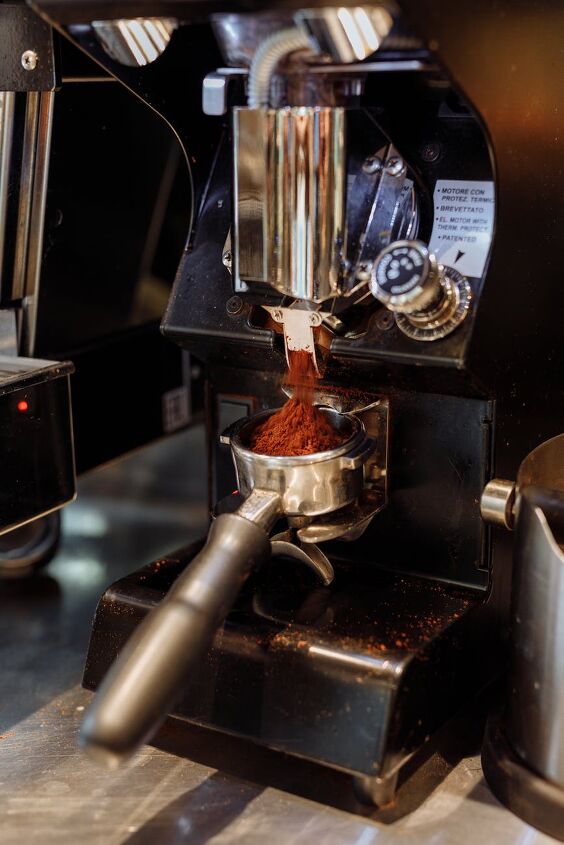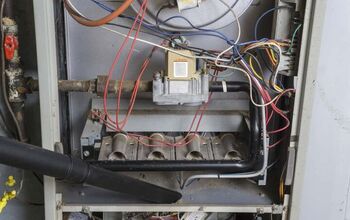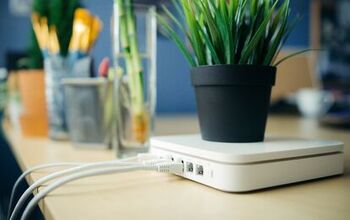Why Is My Keurig So Loud? (Possible Causes & Fixes)

Keurig coffee makers are among the most popular on the planet, and people all over the world use them to make great coffee every day. And these sleek and popular coffee makers are more than a beautiful accessory that sits next to the kitchen sink. That also has resulted in many questions surrounding these beloved coffee machines. Questions like why is my Keurig so loud?
Keurig coffee makers can be loud because of the type of model, mineral deposits, or lack of maintenance. Older versions of the Keurig, for example, don’t have quiet brew technology. If your Keurig is loud, it may also be indicative of a problem, from needed cleaning to buildup and clogging from impurities or possibly more serious issues like a motor failure.
There are a number of causes that could result in your Keurig coffee maker running loudly. Some of those causes mean there is something wrong, others don’t. Diagnosing the sound and addressing it will determine what needs to be done.
Do You Need Appliance Installation or Replacement?
Get free, zero-commitment quotes from pro contractors near you.

Diagnosing the Sound
While there are reasons that your Keurig may be running loudly, that doesn’t always mean that there’s a problem. The first step in resolving the issue of your Keurig operation so loudly is determining what kind of sound your coffee machine is making.
Sometimes the fix is simple, quick, and easy. Sometimes the way to quiet down that noisy Keurig might take a little work, a little expense, or both. And sometimes that fix is the worst-case scenario. Beginning with those loud sounds while your Keurig is running, we need to ask what kind of sounds are being made?
Rattling, Clicking, or Vibrating Sounds
If your Keurig is operating loudly, are the sounds it’s making similar to a rattling sound? Are the sounds more like loud or constant vibration? If these are the sounds you are hearing, the fix may be very good news, and as simple as relocating your coffee machine.
Often these sounds can be the result of the type of surface your Keurig is sitting on. It may also be the result of an uneven or slanted surface. Simply placing the coffee maker on a flat, solid, and level surface may resolve this issue and eliminate those vibrations or rattling sounds.
Is the sound you are hearing more like a clicking sound? If this is the noise you are hearing, there is also a good chance this could be a relatively simple fix. In many cases, this type of sound can be the result of a loose canister (e.g. water reservoir container), lid, or other moveable parts.
Fixing this issue might take a little more time to carefully check all the moveable parts, and to verify every piece is secure, attached, and fitting properly. Loose parts and improperly seated compartments of the Keurig coffee maker can often be the culprit behind those annoying and loud rattling sounds.
Loud Suction or Hissing Sounds
Another common sound that Keurig owners may encounter is an almost obnoxious sounding suction. The good news is that this is typically a normal sound for Keurig machines and most coffee makers, including older Keurig versions.
These sounds are generally the result of the remaining water being drawn from the water reservoir. This is akin to sucking the last few drops from your cup with a straw. The same principle applies here, and unless you have a newer Keurig, then this is a normal sound of your Keurig brewing your next perfect cup of coffee.
Occasionally, and perhaps more often than that, your Keurig may emit a rather loud hissing-type sound. This is one part because of that aforementioned suction issue combined with the heating of water in the Keurig. Water vapor as it is heated rises and can create a hissing sound when enters the suction tubes from the water reservoir.
Once again, this is not indicative of a problem, only the process of Keurig coffee machines brewing coffee. This issue is also more common with older model Keurig coffee makers (those without quiet brew technology).
Grinding Sounds or Keurig Getting Louder
Another common sound that Keurig owners may hear is one that is manageable but also problematic. Grinding sounds or normal brewing sounds that are getting louder are often the results of the normal buildup of impurities, and the need for descaling.
Those who use tap water for their Keurig coffee makers increase the amount and time it takes for the buildup of chemicals, microorganisms, and bacteria, and other contaminants. Keurig recommends the use of filtered water to help reduce and minimize such buildup.
Unfortunately, and eventually, these deposits and buildups will need to be addressed with cleaning and descaling, regardless of what type of water is used. As the Keurig heats the water, calcium and other minerals inevitably collect and build up, creating issues and problems inside the coffee machine.
Regular cleaning and descaling can remove these buildups, improve the health of your coffee machine, the taste of your coffee, and can help make your Keurig less loud.
Cleaning and Descaling Keurig Coffee Makers
There is more than one way to clean a Keurig coffee maker. This is a proven and effective method that works, and only takes a little time, money, and effort.
Begin by getting all the cleaning supplies you may need. These can include:
- Keurig Water Filter Refill Cartridges – $29.99
- White Vinegar – $3.29
- Keurig Descaling Solution – $6.74
- Keurig 2.0 Needle Cleaning Tool – 3.49
If you don’t have gloves, it is advisable to get and use them. Now we are ready to thoroughly clean our Keurig and descale the coffee machine.
Step 1: Turn Off Power
Unplug the Keurig coffee maker to avoid any injury to yourself or harm to the machine.
Step 2: Disassemble Coffee Maker
Take apart the water reservoir and lid, along with the mug tray and K-cup holder compartment.
Step 3: Clean Tray And Cup Holder
Using warm soapy water carefully wash the mug tray and K-cup holder.
Step 4: Clean Reservoir
Clean the water reservoir and lid by wiping them with a soapy damp cloth.
Step 5: Rinse and Dry Parts
Rinse the parts with warm water and set them on a cotton towel to air dry.
Step 6: Clean Surface Areas
Wipe off all surface areas with a warm wet sponge.
Step 7: Reassemble Coffee Maker
Now you are ready to carefully reassemble the Keurig and plug it back in.
This process is important to do regularly. Regular cleaning helps to prevent bacteria and mold and ensures our coffee is safer and tastes good too.
Descaling the Keurig Coffee Maker
Although general and regular cleaning is important to the life of your Keurig and the quality of your coffee, it doesn’t help with those aforementioned deposits, buildups, and that noise. Descaling is the process of removing those impurities and buildups and can help to reduce the noise of your Keurig.
The descaling process isn’t terribly difficult and can be done in less than an hour. This is how to descale a Keuring coffee machine.
Step 1: Fill Reservoir With Cleaning Solution/Vinegar
Using either distilled white vinegar or descaling solution, fill the water reservoir with 16 oz of one or the other. Add 16 oz of clean clear water.
Step 2: Run A Full Brew Cycle
Place a mug in the tray and begin a full cup brew cycle without a K-cup. Allow the coffee maker to complete the brewing process.
Step 3: Repeat Brew Cycle Until Reservoir Is Empty
Repeat this process until the water reservoir is empty (Add Water indicator will be illuminated when done).
Step 4: Cool The Coffee Maker
Allow the coffee machine to sit for 30 minutes.
Step 5: Rinse Reservoir
Be sure to rinse the reservoir thoroughly, then fill the reservoir with water and run 12 brew cycles.
Step 6: Brew Coffee
Now brew and enjoy your next cup of coffee as normal.
These steps will help to ensure that your Keurig remains running properly, continues making coffee that is safe and tastes good, and it can extend the life of your coffee maker. Oh yes, and it can help your Keurig to run more quietly as well.
Despite the cleaning and descaling process being effective, smart, and easy, it doesn’t always help to reduce the sound of that loud Keurig coffee maker.
That leads to the other possible and not so pleasant causes behind the loud noise coming from our Keurig. In some cases, if you hear those grinding noises but the maker isn’t pumping water, it could be a more serious issue. This could be the result of air getting into the machine, or even signs of an imminent motor failure.
In these cases, a replacement motor, service call, or replacement Keurig is typically the best answer to the problem. It is worth noting that if the motor in a Keurig fails, there won’t be any loud noises – or any noise at all.
Do You Need Appliance Installation or Replacement?
Get free, zero-commitment quotes from pro contractors near you.

Related Questions
How often should I clean my Keurig?
There are many benefits to regular cleaning, but how often should your Keurig coffee maker get cleaned. While this will depend on the quantity and frequency of use, removable parts should be cleaned daily.Descaling isn’t necessary on a daily or weekly basis, but descaling your Keurig every two or three months is good for the health and life of your coffee maker, and perhaps that noise issue as well.
Do new Keurig coffee makers make less noise?
Those who own older Keurig coffee makers will have machines without quiet brew technology. Today, these coffee machines are more than decorum for the kitchen. Over the years, Keurig has improved their coffee machines, and the noise they make.

We are a team of passionate homeowners, home improvement pros, and DIY enthusiasts who enjoy sharing home improvement, housekeeping, decorating, and more with other homeowners! Whether you're looking for a step-by-step guide on fixing an appliance or the cost of installing a fence, we've here to help.
More by Upgraded Home Team





















![Cost To Drill A Well [Pricing Per Foot & Cost By State]](https://cdn-fastly.upgradedhome.com/media/2023/07/31/9074980/cost-to-drill-a-well-pricing-per-foot-cost-by-state.jpg?size=350x220)





